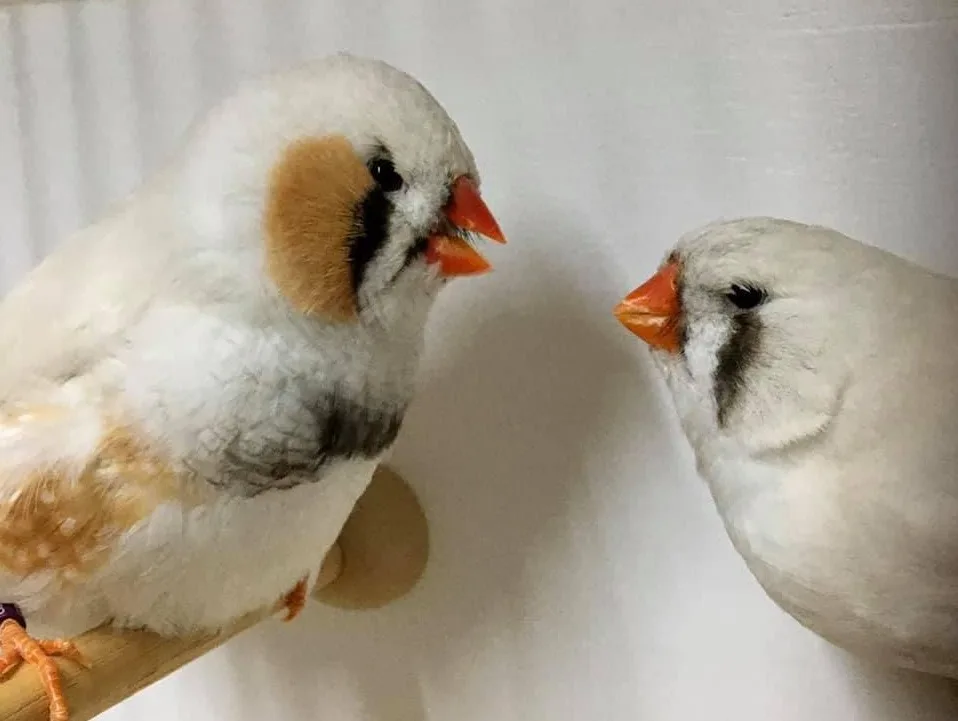Here’s an extremely popular zebbie mutation whose unique selling point is the impossible demands it makes on the breeder. DAVE BROWN ought to know – he’s one of those breeders!
THE chestnut-flanked white, or CFW, zebra finch is, arguably, one of the most eye-catching of mutations. Its attractiveness is down to the contrast between the pure white body combined with the characteristic markings of black tear marks, tail barring and chest barring. To those can be added the contrasting orange cheeks and, as the name suggests, chestnut flanks.
The white zebra finch is a separate variety. In whites, both cocks and hens should be devoid of any of the characteristic zebra finch markings or any other markings. Some whites can sport grizzling or markings, particularly along the back, and these are deemed show faults.
Whites are, in fact, pied mutation zebra finches that do not sport any dark patches. For this reason they should not be crossed into other standard mutations without purpose. That is because white feathers in a line of normal, fawns or CFWs, for example, are exactly what you don’t want.
Returning to our main theme: this contrast in plumage and markings is vital in a line of CFWs intended for the show bench. Judges often knock birds back in the class line-up if they are down in colour. However, to maintain colour in show birds that also need to display cobby type and a bit of size can be a real challenge.
The essential difficulty is that the buff feather which creates a cobby appearance also means that the feather displays less colour. Colour always needs to be a factor in your stock selection with CFWs, but never to the detriment of ignoring type.
The basics of pairing
Although it pays to concentrate on one or two mutations when you are producing exhibition zebra finches, pairing CFW to CFW repeatedly over generations will generally see a decline in colour. It therefore pays to introduce a normal to your CFW pairings, because this will help to strengthen the colour and will often help to improve type. For example, a normal hen put through a CFW line every three years is a good strategy. Hens are preferable over cocks because CFW is sex-linked to the normal, so a CFW cock paired to a normal hen will see CFW hens produced in the first generation. That means, in turn, that you will have birds to reintroduce to your CFW line in the quickest possible timeframe. The normal cocks produced will be split for CFW.
I would not dip into normal too often, because a combination of head flecking and a grey tone to the overall body colour can be the result.
The normal is very much the mutation to use when aiming to improve CFWs. Crossing to fawn often results in birds with a cream shading to the body plumage; moreover, the use of dilutes such as lightback and silver will also see a move in the wrong direction because the markings will often be diluted.
Another CFW mutation also exists, known as the continental CFW. As the name implies, this is the mutation regarded as “the CFW” in Europe. In these birds, although the intensity of colour in the markings is extremely strong, the back of the birds is cream-coloured in appearance. That is far removed from the requirements of the UK standard, whereby the birds are required to be as pure white as possible. Breeders have tried to cross the continental bird into the UK CFW in an effort to improve colour. However, these crosses rarely work, because the cream shading seems to be fairly dominant. Hence, although the cock birds may have improved strength of colour in the markings – including strong tail bars – the colour in the hens’ tails rarely seems to follow suit. Consequently, you end up with a pair that do not match in the show cage, since one has a deeply coloured tail while the other is light.
CFWs provide a continual challenge for those who take them up. Effectively, you are drawn into an endless battle to try and produce birds that have to adhere to a standard which in reality is a contradiction in terms. There are two opposites which have to be merged, one that is full of pigment and at the same time one that is completely devoid of it. Good luck!
Dave Brown is a champion breeder/exhibitor of zebra finches and a ZFS panel judge.
Find more news and articles like this on the Cage & Aviary Birds website. Subscribe to Cage & Aviary Birds magazine now.


